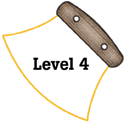
Alaska Science
Key Element A14b
A student who meets the content standard should understand that the living environment consists of individuals, populations, and communities (Interdependence).
 |
Alaska Science A student who meets the content standard should understand that the living environment consists of individuals, populations, and communities (Interdependence). |
|
Performance Standard Level 4, Ages 15–18
|
|
|
|
Sample Assessment Ideas
|
|
|
Expanded Sample Assessment Idea
|
|
Procedure Students will:
Reflection and Revision
|
Levels of Performance |
||
|
Stage 4 |
Student work is complete, shows extensive evidence of knowledge of plant and animal interactions within biomes and evidence of logical reasoning. Student inventory includes: a list of most plant and animal species along with correct identification and population counts; a detailed description of the community and comparison of this specific community to the generalized biome type. Student report shows extensive transfer of knowledge and extension of knowledge in the detailed discussion of how plant and animal interactions vary in different biomes, as well as in man-made vs. natural environments. | ||
|
Stage 3
|
Student work shows evidence of knowledge of plant and animal interactions within biomes as well as logical reasoning but may contain minor errors or omissions. Student inventory includes: a list of plant and animal species along with identification and population counts that are mostly correct; a description of the community and comparison of this specific community to the generalized biome type. Student report shows transfer of knowledge and extension of knowledge in a discussion of how plant and animal interactions vary in different biomes, or in man-made vs. natural environments. | ||
|
Stage 2
|
Student work is incomplete, shows limited evidence of knowledge related to plant and animal interactions or characteristics of biomes and may contain errors of science fact and reasoning. Student inventory includes: a partial listing of plant and animal species along with some identification or population counts. The inventory may lack a description of the community or comparison of this specific community to the generalized biome type. A discussion of plant and animal interactions and different man-made or natural biomes may be absent. | ||
|
Stage 1
|
Student work is largely incomplete, shows little evidence of understanding and may contain major misconceptions related to plant and animal interactions and biomes. | ||
Standards Cross-References
|
||
|
National Science Education Standards Organisms both cooperate and compete in ecosystems. The interrelationships and interdependencies of these organisms may generate ecosystems that are stable for hundreds or thousands of years. (Page 186) Living organisms have the capacity to produce populations of infinite size, but environments and resources are finite. This fundamental tension has profound effects on the interactions between organisms. (Page 186) Populations grow or decline through the combined effects of births and deaths, and through emigration and immigration. Populations can increase through linear or exponential growth, with effects on resource use and environmental pollution. (Page 198) Populations can reach limits to growth. Carrying capacity is the maximum number of individuals that can be supported in a given environment. The limitation is not the availability of space, but the number of people in relation to resources and the capacity of Earth systems to support human beings. Changes in technology can cause significant changes, either positive or negative, in carrying capacity. (Page 198) |
Benchmarks Ecosystems can be reasonably stable over hundreds of thousands of years. As any population of organisms grows, it is held in check by one or more environmental factors: depletion of food or nesting sites, increased loss to increased numbers of predators, or parasites. If a disaster such as a flood or fire occurs, the damaged ecosystem is likely to recover in stages that eventually result in a system similar to the original one. (Page 117) |
|
Table of Contents | Return to Alaska Native Knowledge Network